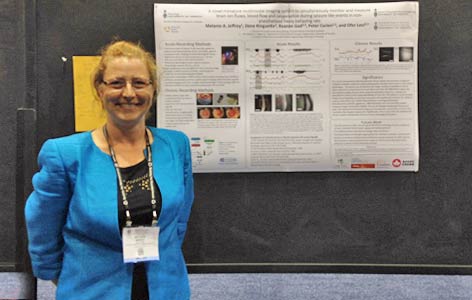Home page Description:
Neuroscience 2015, Oct 16-21, 2015, Chicago, IL
Posted On: August 16, 2016

Image Caption:
Dr. Melanie Jeffrey, PDF
Supervisor: Dr. Peter Carlen, Krembil
Abstract Title: A Novel Miniature Multimodal Imaging System to Simultaneously Monitor and Measure Brain Ion Fluxes, Blood Flow and Oxygenation during Seizure-like Events in Non-anesthetized Freely Behaving Rats
Conference Highlight: There is a great need for smaller, more refined recording devices that enable epilepsy research in freely moving, non-anesthetized animals.
Conference Article: In research, microglia have received much less attention than other brain cells, such as neurons and astrocytes. Until recently, microglia were presumed to be ‘housekeepers’ of the central nervous system (CNS), engulfing cellular debris; however, research presented at the Society for Neuroscience’s annual meeting in 2015 (ie, Neuroscience 2015) showed that microglia play much more complex roles in the brain. Of particular interest was new research that connected maladaptive microglial function to neurological disorders.
Microglia play a role in extracellular signaling and chemical secretion in the CNS. They are ‘activated’ from their resting state in response to neurological injury, changing their gene expression to secrete substances that are important for recruiting more microglia to the site of injury and engulfing damaged cells and debris. In acute inflammation, the secretion of these substances decreases over time. In chronic neuroinflammatory environments, however, microglia are activated for much longer periods of time, and the secretion of some of these substances exacerbate chronic inflammation.
In their resting state, microglia contribute to maintaining homeostasis. They regulate the precise timing of programmed cell death and are implicated in synaptic modeling during different phases of brain development and adulthood. The relationship between chronic stress immune responses and microglial activation may lead to a ‘leaky’ blood-brain barrier, thereby compromising brain homeostasis and function. Microglia have important functions in the hippocampus, where new cells are formed in the CNS throughout the lifespan. They have also been implicated in the pathogenesis of Rett’s syndrome (ie, a severe epilepsy of childhood) and epilepsy.
Conference Highlight: There is a great need for smaller, more refined recording devices that enable epilepsy research in freely moving, non-anesthetized animals.
Conference Article: In research, microglia have received much less attention than other brain cells, such as neurons and astrocytes. Until recently, microglia were presumed to be ‘housekeepers’ of the central nervous system (CNS), engulfing cellular debris; however, research presented at the Society for Neuroscience’s annual meeting in 2015 (ie, Neuroscience 2015) showed that microglia play much more complex roles in the brain. Of particular interest was new research that connected maladaptive microglial function to neurological disorders.
Microglia play a role in extracellular signaling and chemical secretion in the CNS. They are ‘activated’ from their resting state in response to neurological injury, changing their gene expression to secrete substances that are important for recruiting more microglia to the site of injury and engulfing damaged cells and debris. In acute inflammation, the secretion of these substances decreases over time. In chronic neuroinflammatory environments, however, microglia are activated for much longer periods of time, and the secretion of some of these substances exacerbate chronic inflammation.
In their resting state, microglia contribute to maintaining homeostasis. They regulate the precise timing of programmed cell death and are implicated in synaptic modeling during different phases of brain development and adulthood. The relationship between chronic stress immune responses and microglial activation may lead to a ‘leaky’ blood-brain barrier, thereby compromising brain homeostasis and function. Microglia have important functions in the hippocampus, where new cells are formed in the CNS throughout the lifespan. They have also been implicated in the pathogenesis of Rett’s syndrome (ie, a severe epilepsy of childhood) and epilepsy.




